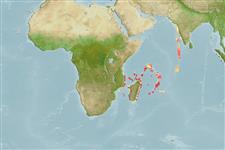Classificatie / Names
Lokale namen | Synoniemen | Catalog of Fishes(Genus, Soort(en)) | ITIS | CoL | WoRMS | Cloffa
>
Eupercaria/misc (Various families in series Eupercaria) >
Labridae (Wrasses) > Cheilininae
Etymology: Pteragogus: Greek, pteron = wing, fin + Greek, ago = to drive (Ref. 45335); variabilis: Named for the great variation in color, not only as shown in color photographs of different fish, but in the same individual.
Environment: milieu / climate zone / depth range / distribution range
Ecologie
marien rifbewoner; diepte 0 - 71 m (Ref. 93522). Tropical
Indian Ocean: Mauritius, Seychelles (Aldabra Atoll), and Cargados Carajos (St. Brandon’s Shoals).
Grootte / Gewicht / Leeftijd
Maturity: Lm ? range ? - ? cm
Max length : 5.8 cm SL mannelijk / geslacht onbekend; (Ref. 93522)
Korte beschrijving
Determinatiesleutels | Morfologie | Morfometrie
Dorsale stekels (totaal) : 11; Dorsale zachte stralen (totaal) : 9; Anale stekels: 3 - 9; Anale zachte stralen: 9; Wervels: 24. This species is distinguished by the following characters: D XI,9; A III,9; pectoral rays 13-14 (usually 13), the rays flattened at tips but not branched; complete lateral line, angling sharply downward below soft portion of anal fin to straight peduncular part; pored scales 24 (plus 2 on base of caudal fin, the last greatly enlarged); body moderately deep, 2.7-3.05 depth in SL; head length 2.55-2.6 in SL; dorsal profile of head straight; straight part of posterior margin of preopercle serrate, serrae varying from 13 on 3.4-cm paratype to 25 on 5.8-cm paratype; absence of long filaments extending from tips of dorsal spines; rounded caudal fin and moderately long 3.1-3.15 in SL; first soft ray of pelvic fins moderately long, reaching between origin of anal fin and origin of soft portion of anal fin, 3.2-4.1 in SL. Colour in life very variable, with the ground color being brown, sometimes suffused with orange, red, or yellow; or greenish gray, orange-yellow, or red; all sharing the following features: opercle of darker color, often more red, orange, or yellow than rest of head, and containing an oblique elliptical ocellus; four white spots along anterior lateral line, the fourth anteriorly on caudal peduncle, with irregular white spots and flecks extending dorsally from first three spots into dorsal fin, and ventrally from all four spots; a broad white posterior border on preopercle, with an adjacent white triangular band on opercle; white dots extending ventrally and posteroventrally from orbit; median and pelvic fins colored much like adjacent body, but with more small white blotches and dots; dorsal fin with a blackish spot on first membrane and usually a smaller spot on second membrane; about posterior three-fourths of soft portion of fin transparent, except basally (the transparent zone may be crossed by brown lines); caudal fin with a series of white or transparent spots along dorsal margin and smaller spots along ventral margin; color in alcohol pale brownish yellow, an oblique elliptical ocellus about twice pupil diameter in length on opercle (often damaged, sometimes effaced), a short dark brown dash on side of snout before middle of eye, dark dots sometimes faintly visible on nape, fins translucent pale yellowish with the dorsal having a blackish spot on first membrane and usually a second smaller spot on second membrane, a small dark brown spot at rear base of dorsal fin; some specimens, including holotype, may be entirely pale yellowish with no dark markings (Ref. 93522).
Levenscyclus en paargedrag
Maturiteit | Voortplanting | Paaien | Eieren | Fecunditeit | Larven
Oviparous, distinct pairing during breeding (Ref. 205).
Randall, J.E., 2013. Seven new species of labrid fishes (Coris, Iniistius, Macropharyngodon, Novaculops, and Pteragogus) from the Western Indian Ocean. J. Ocean Sci. Found. 7:1-43. (Ref. 93522)
Status op de Rode Lijst van het IUCN (Ref. 130435: Version 2024-1)
Gevaar voor de mens
Harmless
Gebruik door de mens
Tools
Speciale rapporten
Download XML
Internetbronnen
Estimates based on models
Preferred temperature (Ref.
123201): 26.3 - 27.3, mean 26.5 °C (based on 10 cells).
Fylogenetische diversiteitsindex (Ref.
82804): PD
50 = 0.5010 [Uniqueness, from 0.5 = low to 2.0 = high].
Bayesian length-weight: a=0.02138 (0.00871 - 0.05249), b=2.97 (2.76 - 3.18), in cm total length, based on LWR estimates for this (Sub)family-body shape (Ref.
93245).
Trofisch niveau (Ref.
69278): 3.3 ±0.4 se; based on size and trophs of closest relatives
Weerstandsvermogen (Ref.
120179): Hoog, minimale populatieverdubbelingstijd minder dan 15 maanden (Preliminary K or Fecundity.).
Fishing Vulnerability (Ref.
59153): Low vulnerability (10 of 100).
